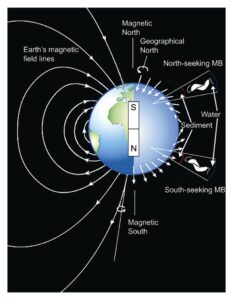Magnetotactic bacteria
Background

Magnetotactic bacteria (MTB) possess an exquisite orientation mechanism allowing them to move along the geomagnetic field lines. This mechanism consists of a chain of bio-synthesized magnetic nano-crystals that endow MTB with a permanent magnetic moment. Although the physics behind the minimum size of this biological compass is well understood, it is yet unclear what sets its maximum size. Here, by using a macroscopic experiment inspired in these microorganisms, we explore the impact of MTB having larger magnetic moments.
In this research we will try to miniaturize the actual platform and explore the structures that form when we control magnetic moments and activity.
IRES student involvement.
Students will be trained in the basics of a model for magnetic active mater. Students will participate in the design and construction of smaller robots that mimic MTB, and we will measure their motion using high-definition cameras, and the short time scale motion will be characterized with high-speed imaging. Students will also learn how to calibrate magnets and the basic notions of correlations.
References
[1] Goswami, P., He, K., Li, J., Pan, Y., Roberts, A. P., & Lin, W. (2022). Magnetotactic bacteria and magnetofossils: Ecology, evolution and environmental implications. npj Biofilms and Microbiomes, 8(1), 43.
[2] Faivre, D., & Schuler, D. (2008). Magnetotactic bacteria and magnetosomes. Chemical reviews, 108(11), 4875-4898.
[3] Sepúlveda, N., Guzmán-Lastra, F., Carrasco, M., González, B., Hamm, E., & Concha, A. (2021). Bioinspired magnetic active matter and the physical limits of magnetotaxis. arXiv preprint arXiv:2111.04889.